Ca2+-dimethylphosphate complex formation: providing insight into Ca2+-mediated local dehydration and membrane fusion in cells
- PMID: 18452809
- PMCID: PMC4580261
- DOI: 10.1016/j.cellbi.2008.03.002
Ca2+-dimethylphosphate complex formation: providing insight into Ca2+-mediated local dehydration and membrane fusion in cells
Abstract
Earlier studies using X-ray diffraction, light scattering, photon correlation spectroscopy, and atomic force microscopy, strongly suggest that SNARE-induced membrane fusion in cells proceeds as a result of calcium bridging opposing bilayers. The bridging of phospholipid heads groups in the opposing bilayers by calcium leads to the release of water from hydrated Ca(2+) ions as well as the loosely coordinated water at PO-lipid head groups. Local dehydration of phospholipid head groups and the calcium, bridging opposing bilayers, then leads to destabilization of the lipid bilayers and membrane fusion. This hypothesis was tested in the current study by atomistic molecular dynamic simulations in the isobaric-isothermal ensemble using hydrated dimethylphosphate anions (DMP(-)) and calcium cations. Results from the study demonstrate, formation of DMP-Ca(2+) complexes and the consequent removal of water, supporting the hypothesis. Our study further demonstrates that as a result of Ca(2+)-DMP self-assembly, the distance between anionic oxygens between the two DMP molecules is reduced to 2.92A, which is in close agreement with the 2.8A SNARE-induced apposition established between opposing bilayers, reported earlier from X-ray diffraction measurements.
Figures











Comment in
-
Membrane fusion--new light on the atomic organization of ions and molecules at the inter-bilayer leading to dehydration.Cell Biol Int. 2008 Apr;32(4):359-60. doi: 10.1016/j.cellbi.2008.03.003. Epub 2008 Mar 20. Cell Biol Int. 2008. PMID: 18452808 No abstract available.
Similar articles
-
Understanding membrane fusion combining experimental and simulation studies.Methods Cell Biol. 2008;90:183-98. doi: 10.1016/S0091-679X(08)00809-1. Methods Cell Biol. 2008. PMID: 19195551
-
Role of SNAREs in membrane fusion.Adv Exp Med Biol. 2011;713:13-32. doi: 10.1007/978-94-007-0763-4_3. Adv Exp Med Biol. 2011. PMID: 21432012 Review.
-
Membrane fusion: role of SNAREs and calcium.Protein Pept Lett. 2009;16(7):712-7. doi: 10.2174/092986609788681869. Protein Pept Lett. 2009. PMID: 19601899 Review.
-
Assembly and disassembly of SNAREs in membrane fusion.Methods Cell Biol. 2008;90:157-82. doi: 10.1016/S0091-679X(08)00808-X. Methods Cell Biol. 2008. PMID: 19195550
-
Membrane fusion in cells: molecular machinery and mechanisms.J Cell Mol Med. 2006 Apr-Jun;10(2):423-7. doi: 10.1111/j.1582-4934.2006.tb00409.x. J Cell Mol Med. 2006. PMID: 16796809 Free PMC article. Review.
Cited by
-
'Porosome' discovered nearly 20 years ago provides molecular insights into the kiss-and-run mechanism of cell secretion.J Cell Mol Med. 2015 Jul;19(7):1427-40. doi: 10.1111/jcmm.12598. Epub 2015 May 28. J Cell Mol Med. 2015. PMID: 26033351 Free PMC article. Review.
-
Porosome in Cystic Fibrosis.Discoveries (Craiova). 2014 Jul-Sep;2(3):e24. doi: 10.15190/d.2014.16. Discoveries (Craiova). 2014. PMID: 26413568 Free PMC article.
-
Porosome: a membrane microdomain acting as the universal secretory portal in exocytosis.Discoveries (Craiova). 2014 Sep 23;2(3):e29. doi: 10.15190/d.2014.21. Discoveries (Craiova). 2014. PMID: 32309556 Free PMC article. Review.
-
Hydrodynamics govern the pre-fusion docking time of synaptic vesicles.J R Soc Interface. 2018 Jan;15(138):20170818. doi: 10.1098/rsif.2017.0818. J R Soc Interface. 2018. PMID: 29386403 Free PMC article.
-
Neuronal Porosome-The Secretory Portal at the Nerve Terminal: It's Structure-Function, Composition, and Reconstitution.J Mol Struct. 2014 Sep 5;1073:187-195. doi: 10.1016/j.molstruc.2014.04.055. J Mol Struct. 2014. PMID: 26412873 Free PMC article.
References
-
- Bockmann RA, Grubmuller H. Multistep binding of divalent cations to phospholipid bilayers: a molecular dynamics study. Angew. Chem. Int. Ed. 2004;43:1021–1024. - PubMed
-
- Foloppe N, MacKerell AD., Jr An improved empirical potential energy function for molecular simulations of phospholipids. J. Comput. Chem. 2000;21:86–104.
-
- Guan Y, Choy GS-C, Glaser R, Thomas G., Jr Vibrational Analysis of Nucleic Acids. 2. Ab Initio Calculation of the Molecular Force Field and Normal Modes of Dimethyl Phosphate. J. Phys. Chem. 1995;99:12054–12062.
-
- Humphrey W, Dalke A, Schulten K. VMD: Visual molecular dynamics. J. Molec. Graphics. 1996;14:33–38. - PubMed
Publication types
MeSH terms
Substances
Grants and funding
LinkOut - more resources
Full Text Sources
Miscellaneous

